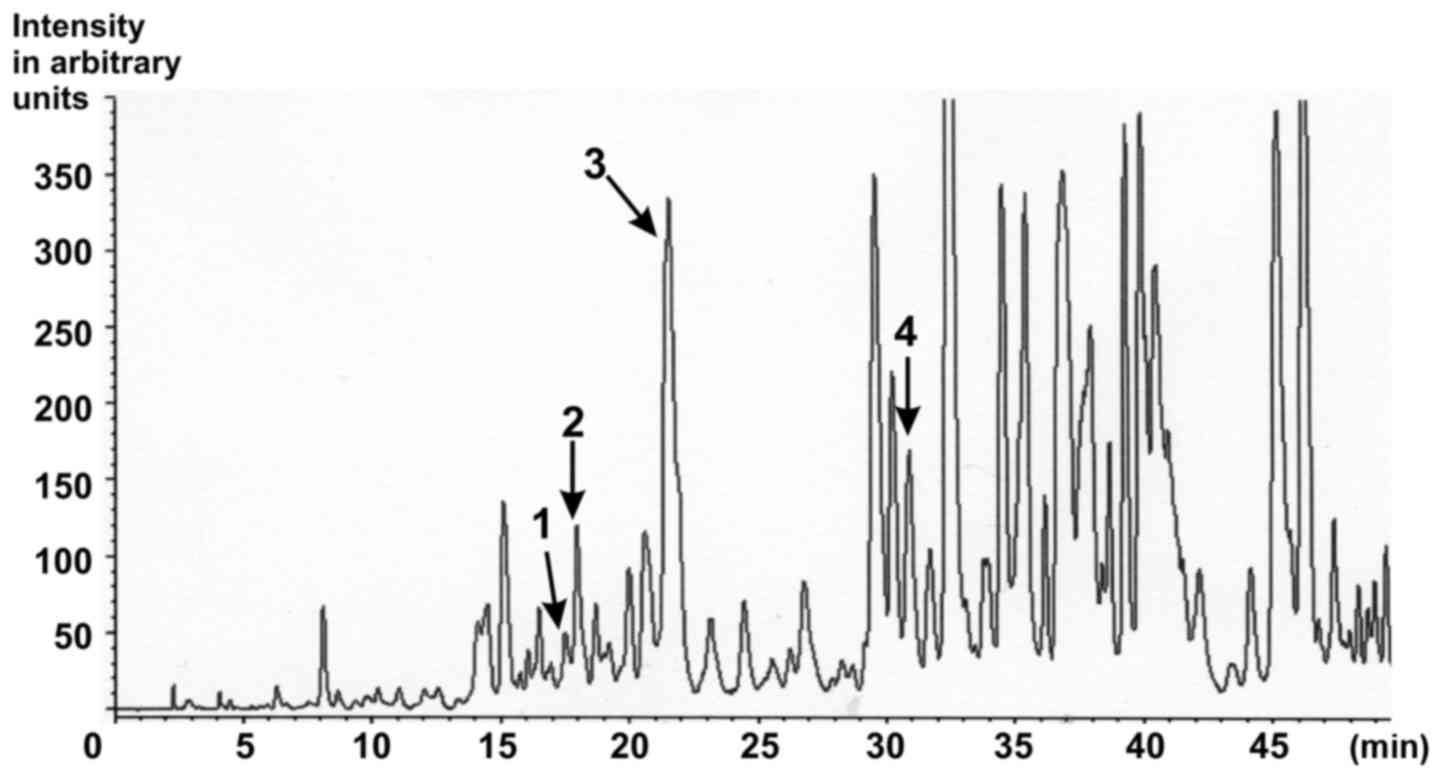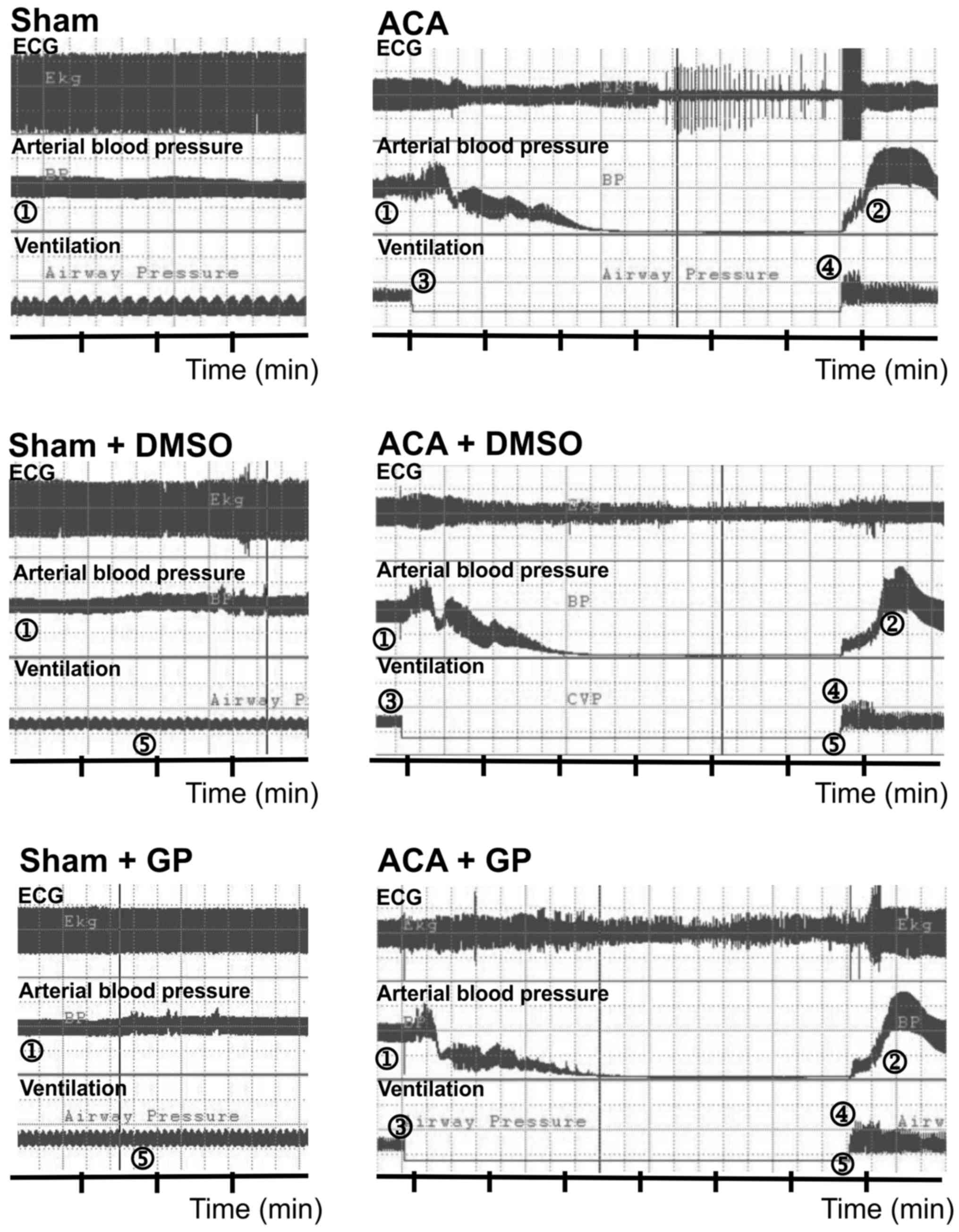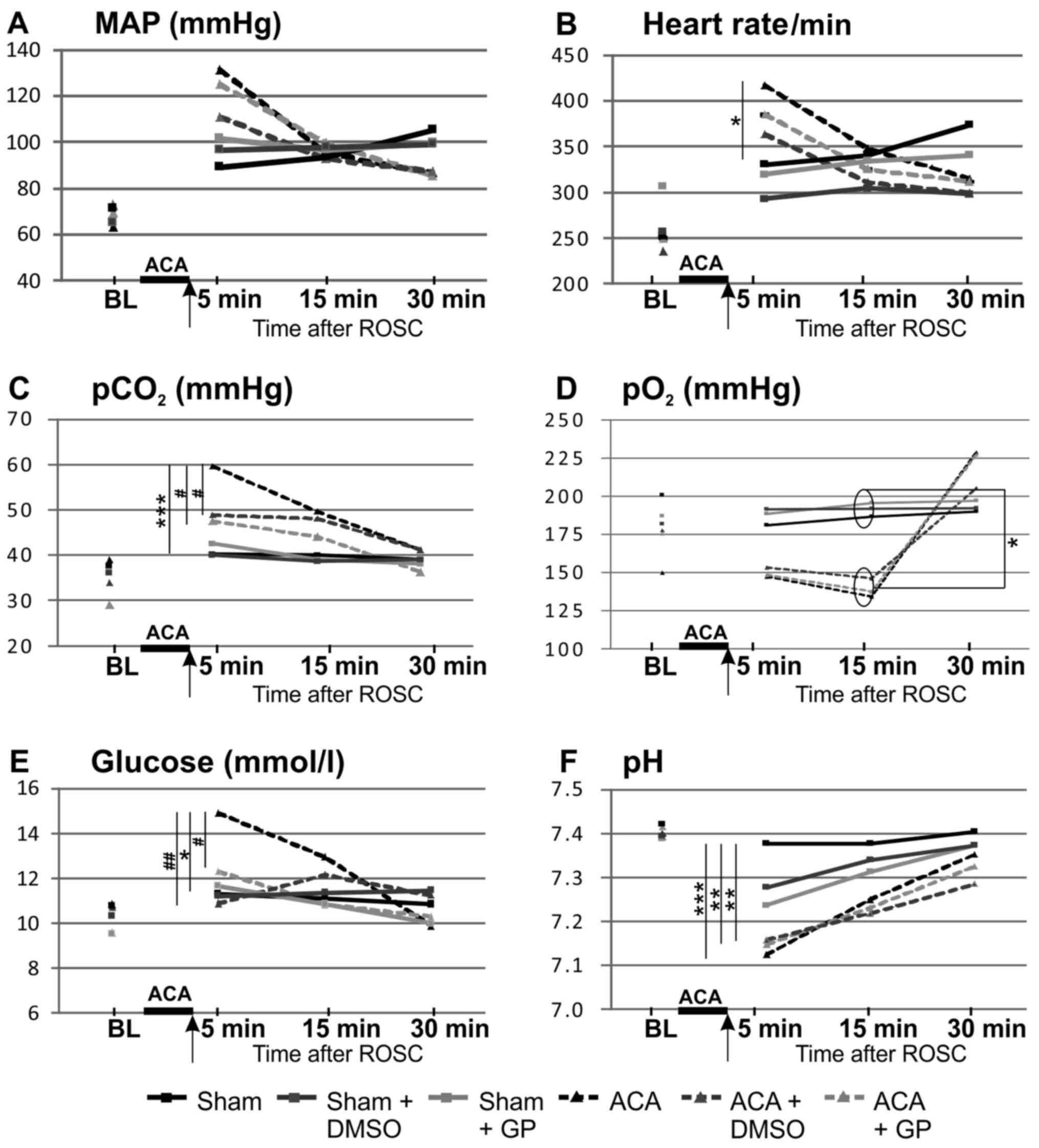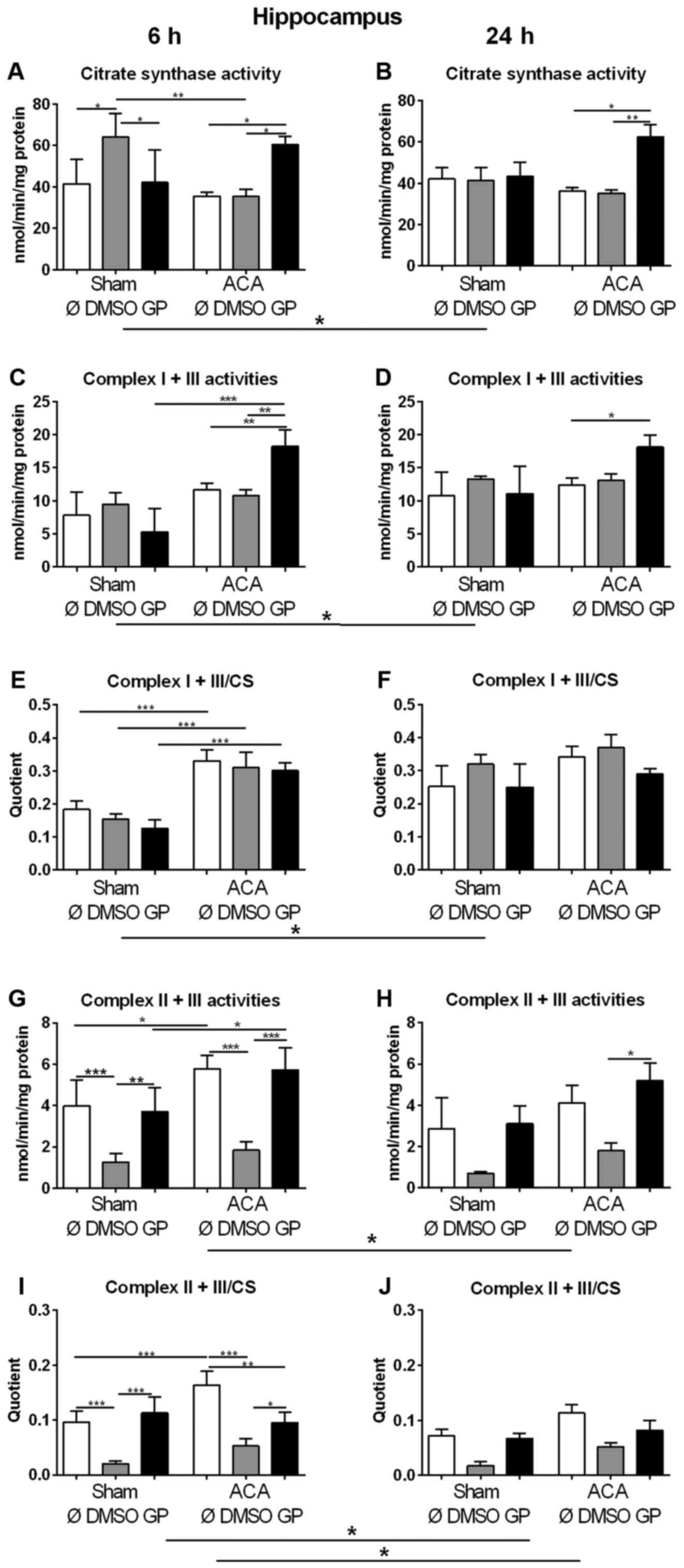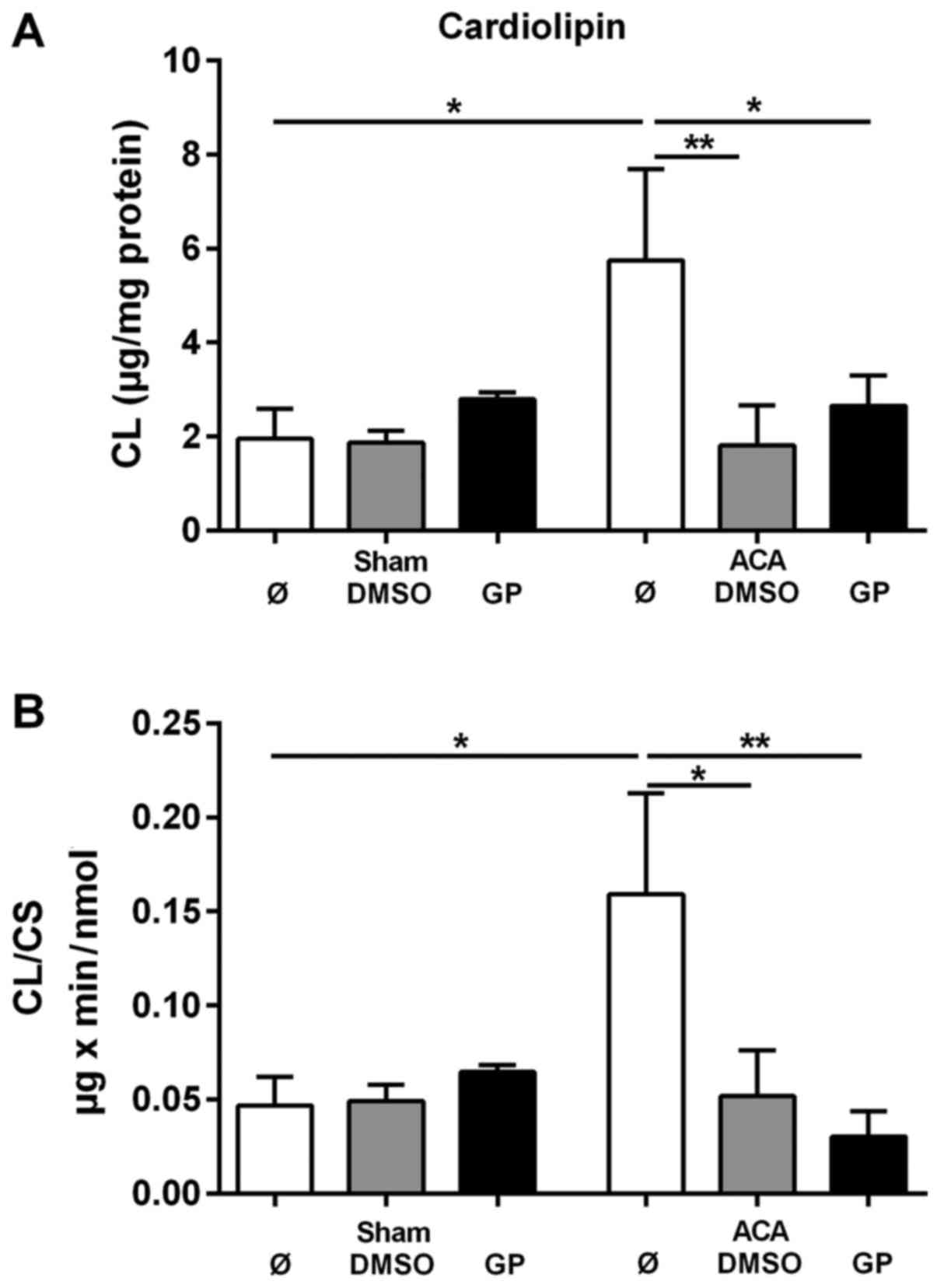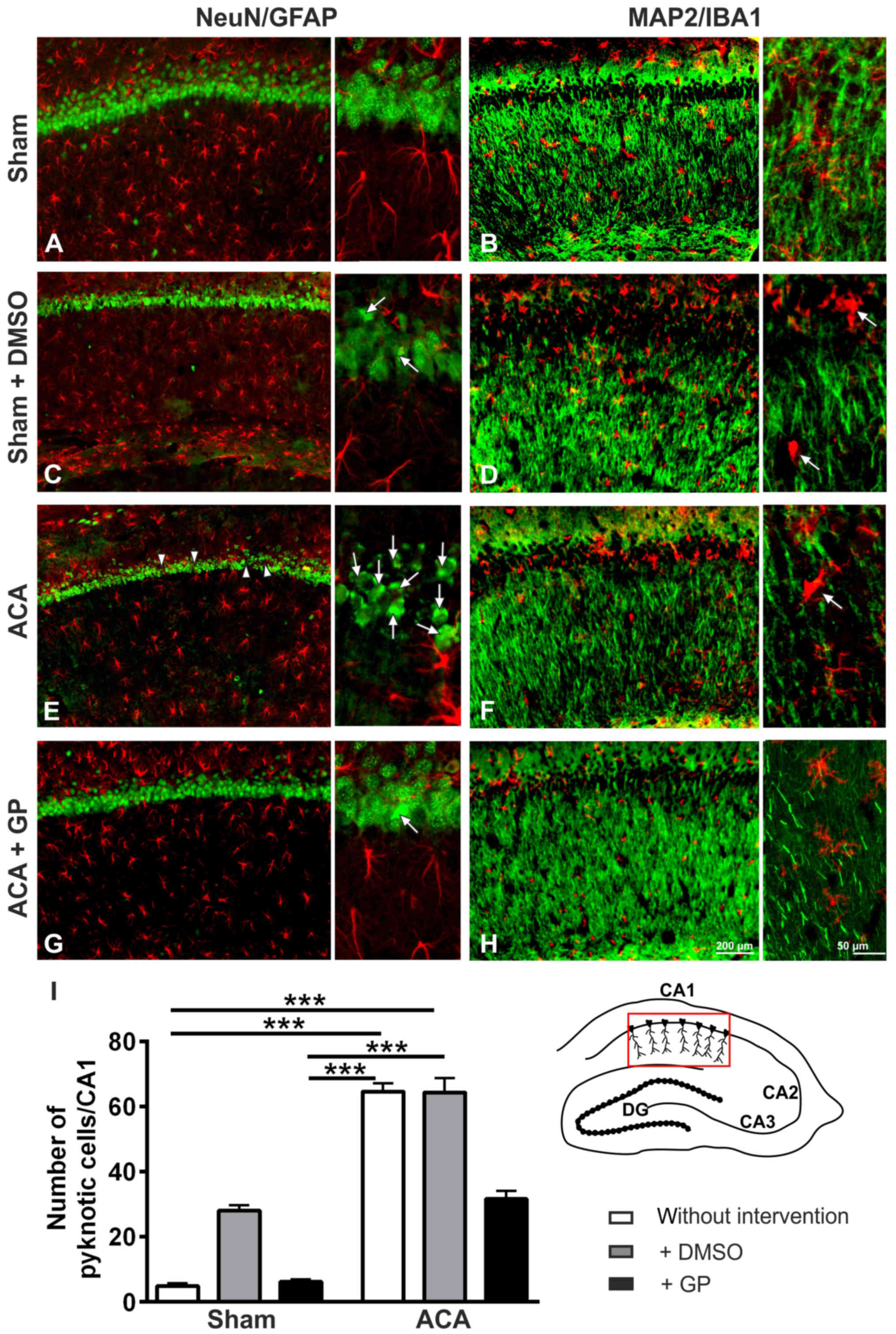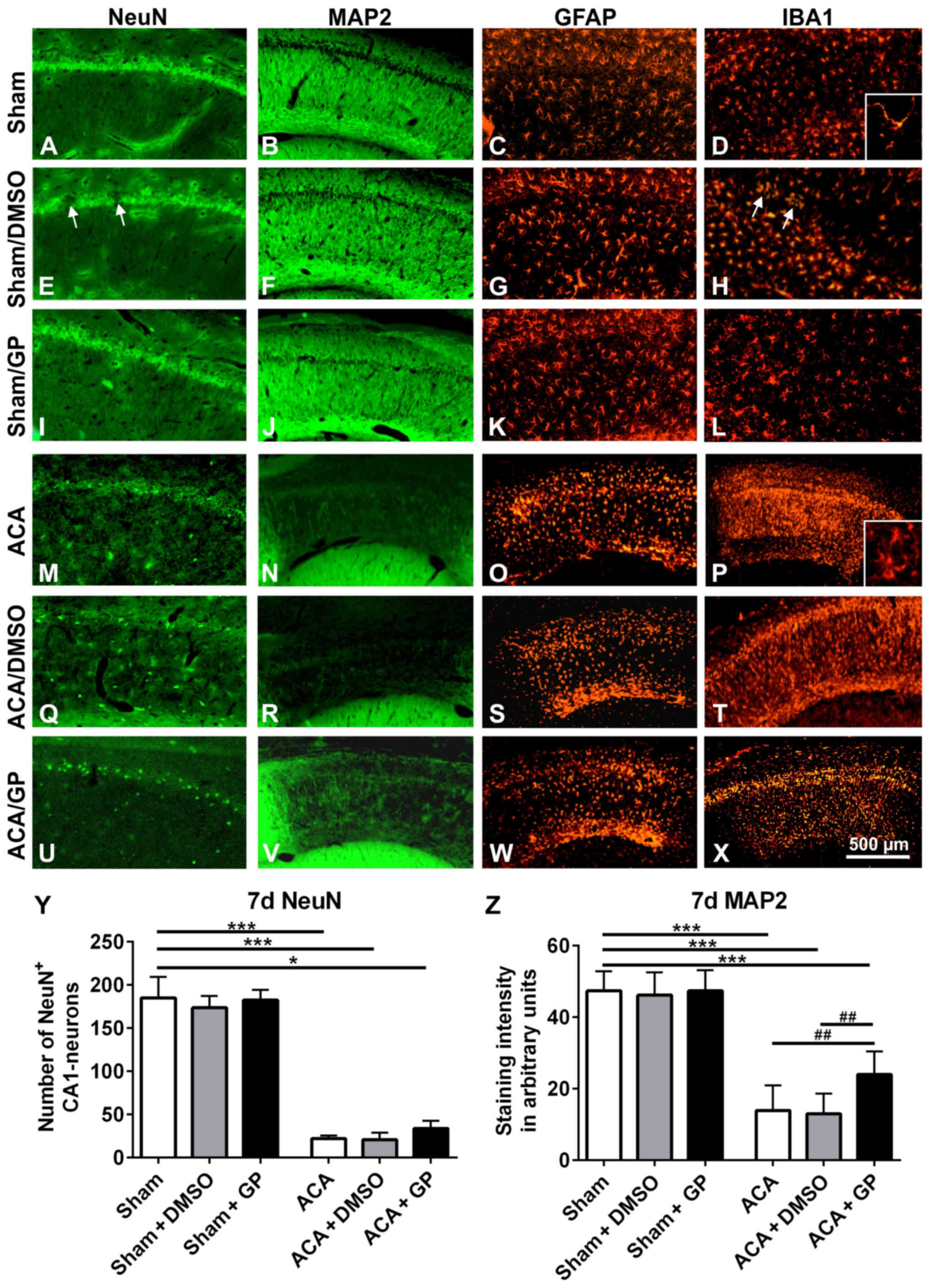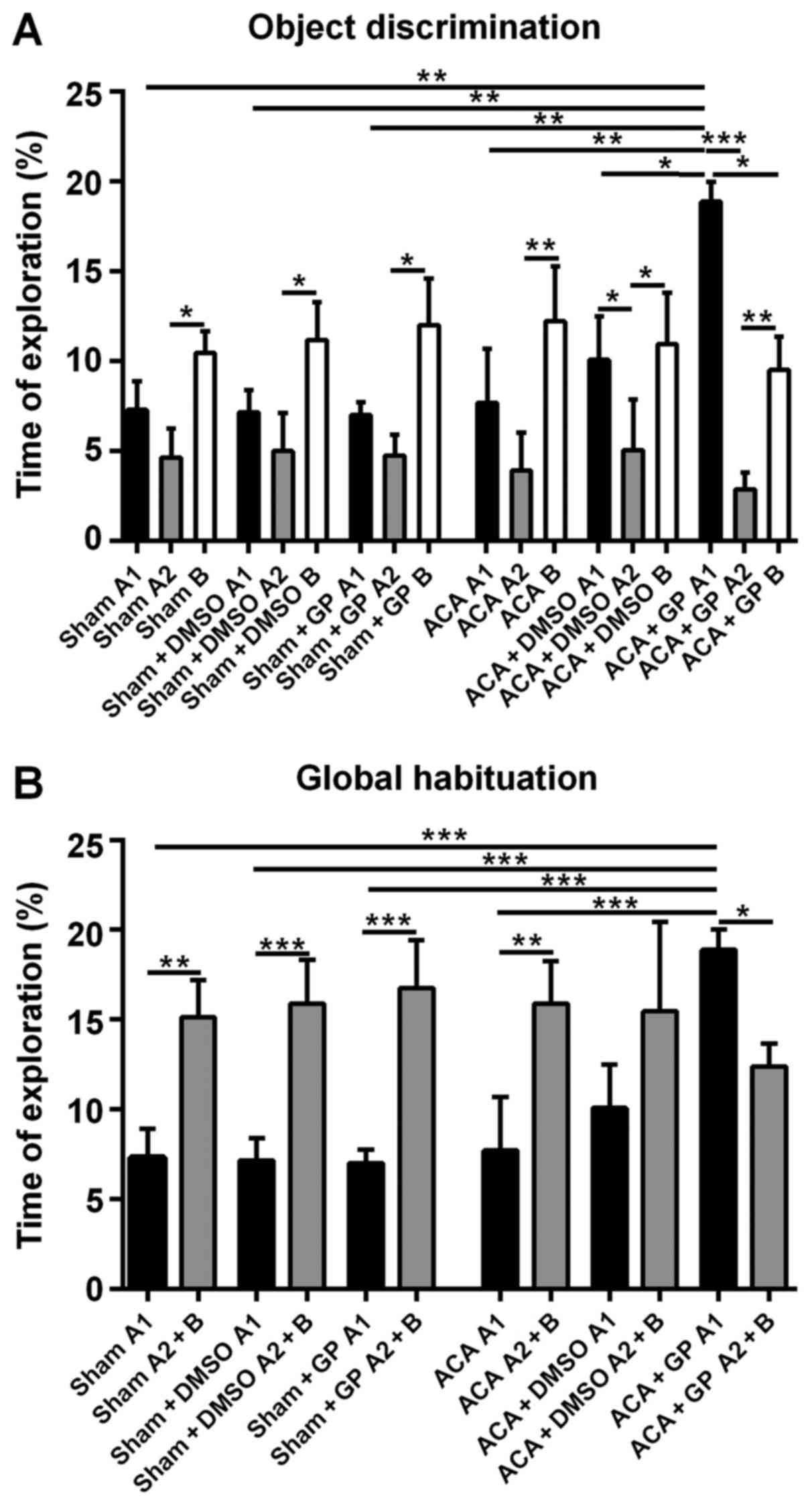|
1
|
Sims NR and Anderson MF: Mitochondrial
contributions to tissue damage in stroke. Neurochem Int.
40:511–526. 2002. View Article : Google Scholar : PubMed/NCBI
|
|
2
|
Schild L and Reiser G: Oxidative stress is
involved in the permeabilization of the inner membrane of brain
mitochondria exposed to hypoxia/reoxygenation and low micromolar
Ca2+. FEBS J. 272:3593–3601. 2005. View Article : Google Scholar : PubMed/NCBI
|
|
3
|
Huang L, Applegate PM, Gatling JW, Mangus
DB, Zhang J and Applegate RL II: A systematic review of
neuroprotective strategies after cardiac arrest: From bench to
bedside (part II-comprehensive protection). Med Gas Res. 4:102014.
View Article : Google Scholar : PubMed/NCBI
|
|
4
|
Mangus DB, Huang L, Applegate PM, Gatling
JW, Zhang J and Applegate RL II: A systematic review of
neuroprotective strategies after cardiac arrest: From bench to
bedside (Part I-Protection via specific pathways). Med Gas Res.
4:92014. View Article : Google Scholar : PubMed/NCBI
|
|
5
|
Sjoberg F and Singer M: The medical use of
oxygen: A time for critical reappraisal. J Int Med. 274:505–528.
2013. View Article : Google Scholar
|
|
6
|
Dell'anna AM, Scolletta S, Donadello K and
Taccone FS: Early neuroprotection after cardiac arrest. Curr Opin
Crit Care. 20:250–258. 2014. View Article : Google Scholar : PubMed/NCBI
|
|
7
|
Llitjos JF, Mira JP, Duranteau J and
Cariou A: Hyperoxia toxicity after cardiac arrest: What is the
evidence? Ann Intensive Care. 6:232016. View Article : Google Scholar : PubMed/NCBI
|
|
8
|
Benjamin EJ, Blaha MJ, Chiuve SE, Cushman
M, Das SR, Deo R, de Ferranti SD, Floyd J, Fornage M, Gillespie C,
et al: Heart disease and stroke statistics-2017 Update: A Report
From the American Heart Association. Circulation. 135:e146–e603.
2017. View Article : Google Scholar : PubMed/NCBI
|
|
9
|
Cheng JG: Investigation of the plant
jiaogulan and its analogous herb, Wulianmei. Zhong Cao Yao.
21:4241990.
|
|
10
|
Mishra RN and Joshi D: Jiao Gu Lan
(Gynostemma pentaphyllum): The Chinese Rasayan-Current
Research Scenario. Int J Res Pharm Biom Sci. 2:1483–1502. 2011.
|
|
11
|
Chen J: Antistress action of Gynostemma
pentaphyllum. Chinese Tradit Patent Med. 11:31–32. 1989.
|
|
12
|
Shang L, Liu J, Zhu Q, Zhao L, Feng Y,
Wang X, Cao W and Xin H: Gypenosides protect primary cultures of
rat cortical cells against oxidative neurotoxicity. Brain Res.
1102:163–174. 2006. View Article : Google Scholar : PubMed/NCBI
|
|
13
|
Norberg A, Hoa NK, Liepinsh E, Van Phan D,
Thuan ND, Jörnvall H, Sillard R and Ostenson CG: A novel
insulin-releasing substance, phanoside, from the plant
Gynostemma pentaphyllum. J Biol Chem. 279:41361–41367. 2004.
View Article : Google Scholar : PubMed/NCBI
|
|
14
|
Wang P, Niu L, Gao L, Li WX, Jia D, Wang
XL and Gao GD: Neuroprotective effect of gypenosides against
oxidative injury in the substantia nigra of a mouse model of
Parkinson's disease. J Int Med Res. 38:1084–1092. 2010. View Article : Google Scholar : PubMed/NCBI
|
|
15
|
Schild L, Roth A, Keilhoff G, Gardemann A
and Brödemann R: Protection of hippocampal slices against
hypoxia/hypoglycemia injury by a Gynostemma pentaphyllum
extract. Phytomedicine. 16:734–743. 2009. View Article : Google Scholar : PubMed/NCBI
|
|
16
|
Paradies G, Paradies V, Ruggiero FM and
Petrosillo G: Cardiolipin and mitochondrial function in health and
disease. Antioxid Redox Signal. 20:1925–1953. 2014. View Article : Google Scholar : PubMed/NCBI
|
|
17
|
Mileykovskaya E and Dowhan W:
Cardiolipin-dependent formation of mitochondrial respiratory
supercomplexes. Chem Phys Lipids. 179:42–48. 2014. View Article : Google Scholar : PubMed/NCBI
|
|
18
|
Nakahara I, Kikuchi H, Taki W, Nishi S,
Kito M, Yonekawa Y, Goto Y and Ogata N: Changes in major
phospholipids of mitochondria during postischemic reperfusion in
rat brain. J Neurosurg. 76:244–250. 1992. View Article : Google Scholar : PubMed/NCBI
|
|
19
|
Ji J, Baart S, Vikulina AS, Clark RS,
Anthonymuthu TS, Tyurin VA, Du L, St Croix CM, Tyurina YY, Lewis J,
et al: Deciphering of mitochondrial cardiolipin oxidative signaling
in cerebral ischemia-reperfusion. J Cereb Blood Flow Metab.
35:319–328. 2015. View Article : Google Scholar : PubMed/NCBI
|
|
20
|
Schild L, Cotte T, Keilhoff G and
Brodemann R: Preconditioning of brain slices against hypoxia
induced injury by a Gynostemma pentaphyllum
extract-stimulation of anti-oxidative enzyme expression.
Phytomedicine. 19:812–818. 2012. View Article : Google Scholar : PubMed/NCBI
|
|
21
|
Zhang GL, Deng JP, Wang BH, Zhao ZW, Li J,
Gao L, Liu BL, Xong JR, Guo XD, Yan ZQ and Gao GD: Gypenosides
improve cognitive impairment induced by chronic cerebral
hypoperfusion in rats by suppressing oxidative stress and
astrocytic activation. Behav Pharmacol. 22:633–644. 2011.
View Article : Google Scholar : PubMed/NCBI
|
|
22
|
Keilhoff G, John R, Langnaese K, Schweizer
H and Ebmeyer U: Triggered by asphyxia neurogenesis seems not to be
an endogenous repair mechanism, gliogenesis more like it.
Neuroscience. 171:869–884. 2010. View Article : Google Scholar : PubMed/NCBI
|
|
23
|
Keilhoff G, Schweizer H, John R, Langnaese
K and Ebmeyer U: Minocycline neuroprotection in a rat model of
asphyxial cardiac arrest is limited. Resuscitation. 82:341–349.
2011. View Article : Google Scholar : PubMed/NCBI
|
|
24
|
Keilhoff G, Titze M, Esser T, Langnaese K
and Ebmeyer U: Constitutive and functional expression of YB-1 in
microglial cells. Neuroscience. 301:439–453. 2015. View Article : Google Scholar : PubMed/NCBI
|
|
25
|
Schild L, Chen BH, Makarov P, Kattengell
K, Heinitz K and Keilhoff G: Selective induction of apoptosis in
glioma tumour cells by a Gynostemma pentaphyllum extract.
Phytomedicine. 17:589–597. 2010. View Article : Google Scholar : PubMed/NCBI
|
|
26
|
Kao TH, Huang SC, Inbaraj BS and Chen BH:
Determination of flavonoids and saponins in Gynostemma
pentaphyllum (Thunb.) Makino by liquid chromatography-mass
spectrometry. Anal Chim Acta. 626:200–211. 2008. View Article : Google Scholar : PubMed/NCBI
|
|
27
|
Moellering H and Gruber W: Determination
of citrate with citrate lyase. Anal Biochem. 17:369–376. 1966.
View Article : Google Scholar : PubMed/NCBI
|
|
28
|
Martens JC, Keilhoff G, Halangk W,
Wartmann T, Gardemann A, Päge I and Schild L: Lipidomic analysis of
molecular cardiolipin species in livers exposed to
ischemia/reperfusion. Mol Cell Biochem. 400:253–263. 2015.
View Article : Google Scholar : PubMed/NCBI
|
|
29
|
Bradford MM: A rapid and sensitive method
for the quantitation of microgram quantities of protein utilizing
the principle of protein-dye binding. Anal Biochem. 72:248–254.
1976. View Article : Google Scholar : PubMed/NCBI
|
|
30
|
Ennaceur A and Delacour J: A new one-trial
test for neurobiological studies of memory in rats. 1: Behavioral
data. Behav Brain Res. 31:47–59. 1988. View Article : Google Scholar : PubMed/NCBI
|
|
31
|
Kandiah P, Ortega S and Torbey MT:
Biomarkers and neuroimaging of brain injury after cardiac arrest.
Semin Neurol. 26:413–421. 2006. View Article : Google Scholar : PubMed/NCBI
|
|
32
|
Schummers J and Browning MD: Evidence for
a role for GABA(A) and NMDA receptors in ethanol inhibition of
long-term potentiation. Brain Res Mol Brain Res. 94:9–14. 2001.
View Article : Google Scholar : PubMed/NCBI
|
|
33
|
Steffensen SC, Nie Z, Criado JR and
Siggins GR: Ethanol inhibition of N-methyl-D-aspartate responses
involves presynaptic gamma-aminobutyric acid(B) receptors. J
Pharmacol Exp Ther. 294:637–647. 2000.PubMed/NCBI
|
|
34
|
Albertson TE and Joy RM: Increased
inhibition in dentate gyrus granule cells following exposure to
GABA-uptake blockers. Brain Res. 435:283–292. 1987. View Article : Google Scholar : PubMed/NCBI
|
|
35
|
Laaris N, Good CH and Lupica CR:
Delta9-tetrahydrocannabinol is a full agonist at CB1 receptors on
GABA neuron axon terminals in the hippocampus. Neuropharmacology.
59:121–127. 2010. View Article : Google Scholar : PubMed/NCBI
|
|
36
|
Zhang G, Xia F, Zhang Y, Zhang X, Cao Y,
Wang L, Liu X, Zhao G and Shi M: Ginsenoside Rd is efficacious
against acute ischemic stroke by suppressing microglial
proteasome-mediated inflammation. Mol Neurobiol. 53:2529–2540.
2016. View Article : Google Scholar : PubMed/NCBI
|
|
37
|
Bakar B, Kose EA, Sonal S, Alhan A, Kilinc
K and Keskil IS: Evaluation of the neurotoxicity of DMSO infused
into the carotid artery of rat. Injury. 43:315–322. 2012.
View Article : Google Scholar : PubMed/NCBI
|
|
38
|
Nurmi J, Boyd J, Anttalainen N,
Westerbacka J and Kuisma M: Early increase in blood glucose in
patients resuscitated from out-of-hospital ventricular fibrillation
predicts poor outcome. Diabetes Care. 35:510–512. 2012. View Article : Google Scholar : PubMed/NCBI
|
|
39
|
Lokman EF, Gu HF, Mohamud Wan WN and
östenson CG: Evaluation of antidiabetic effects of the traditional
medicinal plant gynostemma pentaphyllum and the possible
mechanisms of insulin release. Evid Based Complement Alternat Med.
2015:1205722015. View Article : Google Scholar : PubMed/NCBI
|
|
40
|
Hassan M, Sehgal SA and Rashid S:
Regulatory cascade of neuronal loss and glucose metabolism. CNS
Neurol Disord Drug Targets. 13:1232–1245. 2014. View Article : Google Scholar : PubMed/NCBI
|
|
41
|
Douglas RM, Ryu J, Kanaan A, Del Carmen
Rivero M, Dugan LL, Haddad GG and Ali SS: Neuronal death during
combined intermittent hypoxia/hypercapnia is due to mitochondrial
dysfunction. Am J Physiol Cell Physiol. 298:C1594–C1602. 2010.
View Article : Google Scholar : PubMed/NCBI
|
|
42
|
Sakonju I, Taura Y, Inayoshi Y, Suzuki T,
Takimoto K, Nakaichi M and Nakama S: Cryopreservation of isolated
rat islets of Langerhans in the presence of ethylene glycol or
dimethyl sulfoxide: Evaluation of toxicity and the dynamic pattern
of subsequent insulin release in vitro. Cryobiology. 33:354–362.
1996. View Article : Google Scholar : PubMed/NCBI
|
|
43
|
Berenguer M, Zhang J, Bruce MC, Martinez
L, Gonzalez T, Gurtovenko AA, Xu T, Le Marchand-Brustel Y and
Govers R: Dimethyl sulfoxide enhances GLUT4 translocation through a
reduction in GLUT4 endocytosis in insulin-stimulated 3T3-L1
adipocytes. Biochimie. 93:697–709. 2011. View Article : Google Scholar : PubMed/NCBI
|
|
44
|
Yang CM, Lin CC and Hsieh HL:
High-glucose-derived oxidative stress-dependent heme oxygenase-1
expression from astrocytes contributes to the neuronal apoptosis.
Mol Neurobiol. 54:470–483. 2017. View Article : Google Scholar : PubMed/NCBI
|
|
45
|
Ye R, Zhao G and Liu X: Ginsenoside Rd for
acute ischemic stroke: translating from bench to bedside. Expert
Rev Neurother. 13:603–613. 2013. View Article : Google Scholar : PubMed/NCBI
|
|
46
|
Kim YB, Gidday JM, Gonzales ER, Shah AR
and Park TS: Effect of hypoglycemia on postischemic cortical blood
flow, hypercapnic reactivity and interstitial adenosine
concentration. J Neurosurg. 81:877–884. 1994. View Article : Google Scholar : PubMed/NCBI
|
|
47
|
Yu LS, Fan YY, Ye G, Li J, Feng XP, Lin K,
Dong M and Wang Z: Curcumin alleviates brain edema by lowering AQP4
expression levels in a rat model of hypoxia-hypercapnia-induced
brain damage. Exp Ther Med. 11:709–716. 2016. View Article : Google Scholar : PubMed/NCBI
|
|
48
|
Zhou Y, Li HQ, Lu L, Fu DL, Liu AJ, Li JH
and Zheng GQ: Ginsenoside Rg1 provides neuroprotection against
blood brain barrier disruption and neurological injury in a rat
model of cerebral ischemia/reperfusion through downregulation of
aquaporin 4 expression. Phytomedicine. 21:998–1003. 2014.
View Article : Google Scholar : PubMed/NCBI
|
|
49
|
Yu H, Qi GL, Wang J, Chen L, Deng Z, Zhao
YS, Lei SS and Zhu XQ: Aquaporin 4 inhibition decreased synthesis
of cytokines by acetazolamide in the hippocampus of rats with
pentrazol-induced chronic epilepsy. Genet Mol Res. 15:2016.
View Article : Google Scholar
|
|
50
|
Jiang S, Miao B, Song X and Jiang Z:
Inactivation of GABA(A) receptor reduces ginsenoside Rb3
neuroprotection in mouse hippocampal slices after oxygen-glucose
deprivation. J Ethnopharmacol. 133:914–916. 2011. View Article : Google Scholar : PubMed/NCBI
|
|
51
|
Zhu JR, Tao YF, Lou S and Wu ZM:
Protective effects of ginsenoside Rb(3) on oxygen and glucose
deprivation-induced ischemic injury in PC12 cells. Acta Pharmacol
Sin. 31:273–280. 2010. View Article : Google Scholar : PubMed/NCBI
|
|
52
|
Green CR, Botha JA and Tiruvoipati R:
Cognitive function, quality of life and mental health in survivors
of our-of-hospital cardiac arrest: A review. Anaesth Intensive
Care. 43:568–576. 2015.PubMed/NCBI
|
|
53
|
Popoli M, Yan Z, McEwen BS and Sanacora G:
The stressed synapse: The impact of stress and glucocorticoids on
glutamate transmission. Nat Rev Neurosci. 13:22–37. 2012.
|
|
54
|
Takeda A and Tamano H: Proposed
glucocorticoid-mediated zinc signaling in the hippocampus.
Metallomics. 4:614–618. 2012. View Article : Google Scholar : PubMed/NCBI
|
|
55
|
Joels M: Functional actions of
corticosteroids in the hippocampus. Eur J Pharmacol. 583:312–321.
2008. View Article : Google Scholar : PubMed/NCBI
|
|
56
|
de Kloet ER, Karst H and Joels M:
Corticosteroid hormones in the central stress response:
Quick-and-slow. Front Neuroendocrinol. 29:268–272. 2008. View Article : Google Scholar : PubMed/NCBI
|
|
57
|
Sutt S, Raud S, Abramov U, Innos J, Luuk
H, Plaas M, Kõks S, Zilmer K, Mahlapuu R, Zilmer M and Vasar E:
Relation of exploratory behaviour to plasma corticosterone and Wfs1
gene expression in Wistar rats. J Psychopharmacol. 24:905–913.
2010. View Article : Google Scholar : PubMed/NCBI
|
|
58
|
Yuen EY, Liu W, Karatsoreos IN, Ren Y,
Feng J, McEwen BS and Yan Z: Mechanisms for acute stress-induced
enhancement of glutamatergic transmission and working memory. Mol
Psychiatry. 16:156–170. 2011. View Article : Google Scholar : PubMed/NCBI
|
|
59
|
Hoge J and Kesner RP: Role of CA3 and CA1
subregions of the dorsal hippocampus on temporal processing of
objects. Neurobiol Learn Mem. 88:225–231. 2007. View Article : Google Scholar : PubMed/NCBI
|
|
60
|
Vago DR, Bevan A and Kesner RP: The role
of the direct perforant path input to the CA1 subregion of the
dorsal hippocampus in memory retention and retrieval. Hippocampus.
17:977–987. 2007. View Article : Google Scholar : PubMed/NCBI
|
|
61
|
Piterkin P, Cole E, Cossette MP, Gaskin S
and Mumby DG: A limited role for the hippocampus in the modulation
of novel-object preference by contextual cues. Leam Mem.
15:785–791. 2008. View Article : Google Scholar
|
|
62
|
Zhang G, Zhao Z, Gao L, Deng J, Wang B, Xu
D, Liu B, Qu Y, Yu J, Li J and Gao G: Gypenoside attenuates white
matter lesions induced by chronic cerebral hypoperfusion in rats.
Pharmacol Biochem Behav. 99:42–51. 2011. View Article : Google Scholar : PubMed/NCBI
|
|
63
|
Hong SW, Yang JH, Joh EH, Kim HJ and Kim
DH: Gypenoside TN-2 ameliorates scopolamine-induced learning
deficit in mice. J Ethnopharmacol. 134:1010–1013. 2011. View Article : Google Scholar : PubMed/NCBI
|
|
64
|
Joh EH, Yang JW and Kim DH: Gypenoside
LXXIV ameliorates scopolamine-induced learning deficit in mice.
Planta Med. 76:793–795. 2010. View Article : Google Scholar : PubMed/NCBI
|
|
65
|
Hou ST and MacManus JP: Molecular
mechanisms of cerebral ischemia-induced neuronal death. Int Rev
Cytol. 221:93–148. 2002. View Article : Google Scholar : PubMed/NCBI
|
|
66
|
Szeto HH: Mitochondria-targeted
cytoprotective peptides for ischemia-reperfusion injury. Antioxid
Redox Signal. 10:601–619. 2008. View Article : Google Scholar : PubMed/NCBI
|
|
67
|
Osborne DM, Pearson-Leary J and McNay EC:
The neuroenergetics of stress hormones in the hippocampus and
implications for memory. Front Neurosci. 9:1642015. View Article : Google Scholar : PubMed/NCBI
|
|
68
|
Yu H, Guan Q, Guo L, Zhang H, Pang X,
Cheng Y, Zhang X and Sun Y: Gypenosides alleviate myocardial
ischemia-reperfusion injury via attenuation of oxidative stress and
preservation of mitochondrial function in rat heart. Cell Stress
Chaperones. 21:429–437. 2016. View Article : Google Scholar : PubMed/NCBI
|
|
69
|
Chen DJ, Hu HG, Xing SF, Gao YJ, Xu SF and
Piao XL: Metabolic profiling of Gynostemma pentaphyllum
extract in rat serum, urine and faeces after oral administration. J
Chromatogr B Analyt Technol Biomed Life Sci. 969:42–52. 2014.
View Article : Google Scholar : PubMed/NCBI
|
|
70
|
Nejad KH, Gharib-Naseri MK, Sarkaki A,
Dianat M, Badavi M and Farbood Y: Effects of ellagic acid
pretreatment on renal functions disturbances induced by global
cerebral ischemic-reperfusion in rat. Iran J Basic Med Sci.
20:75–82. 2017.PubMed/NCBI
|
|
71
|
Filippone SM, Samidurai A, Roh SK, Cain
CK, He J, Salloum FN, Kukreja RC and Das A: Reperfusion Therapy
with Rapamycin Attenuates Myocardial Infarction through Activation
of AKT and ERK. Oxid Med Cell Longev. 2017:46197202017. View Article : Google Scholar : PubMed/NCBI
|















